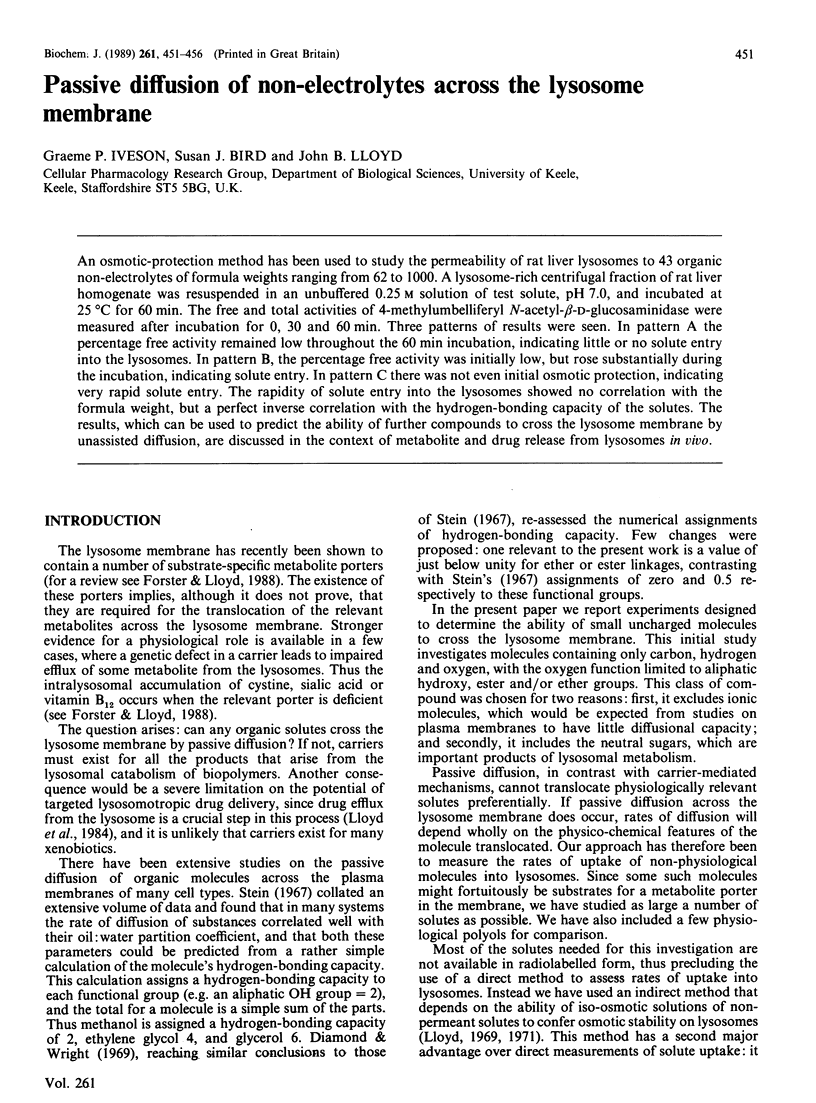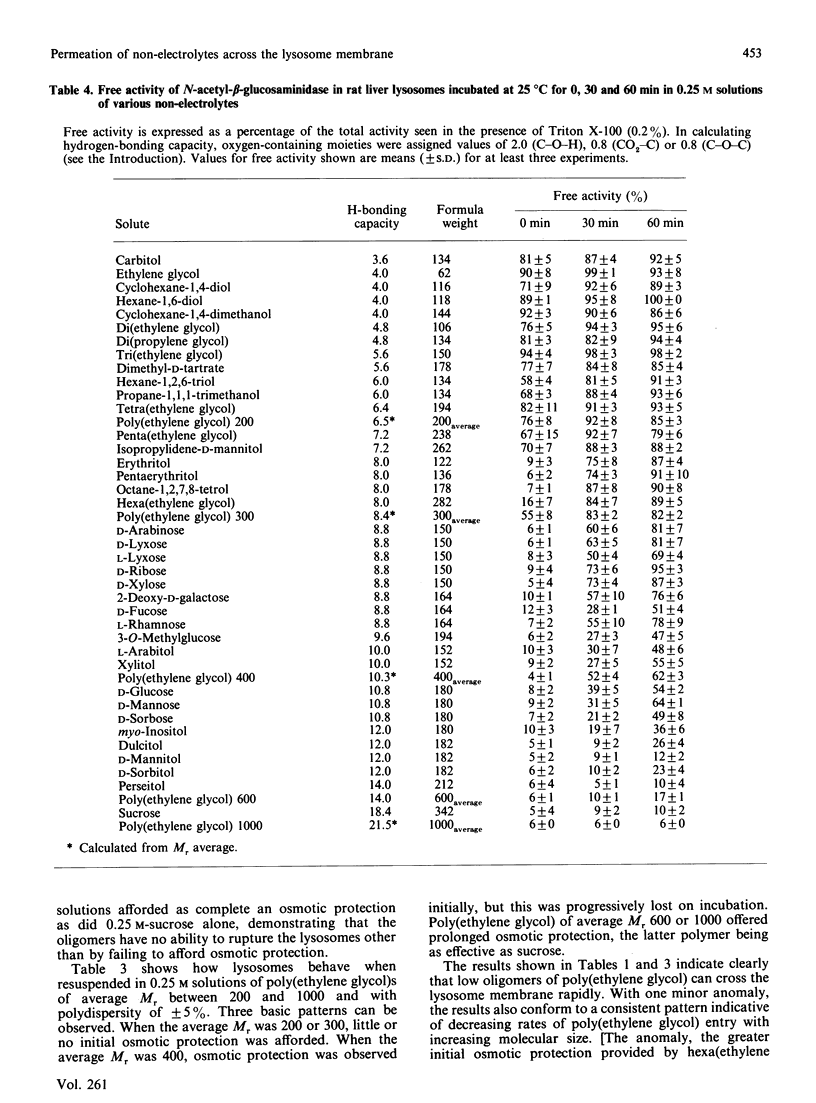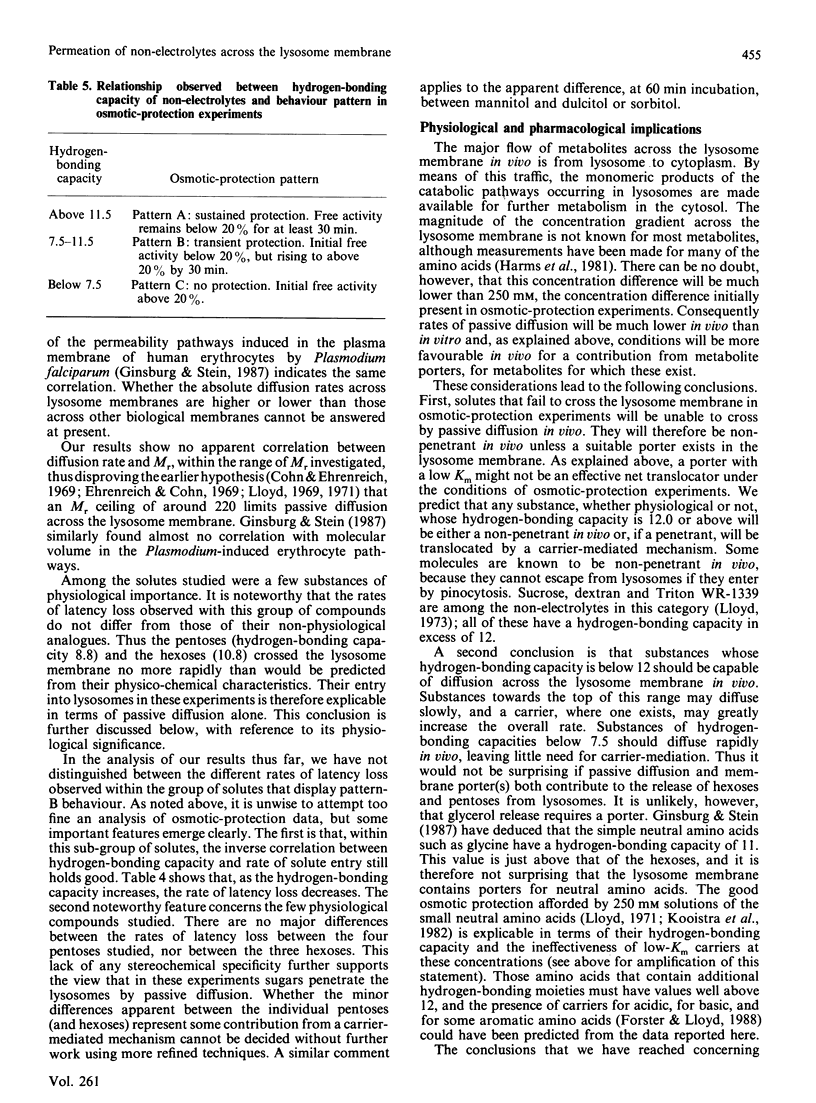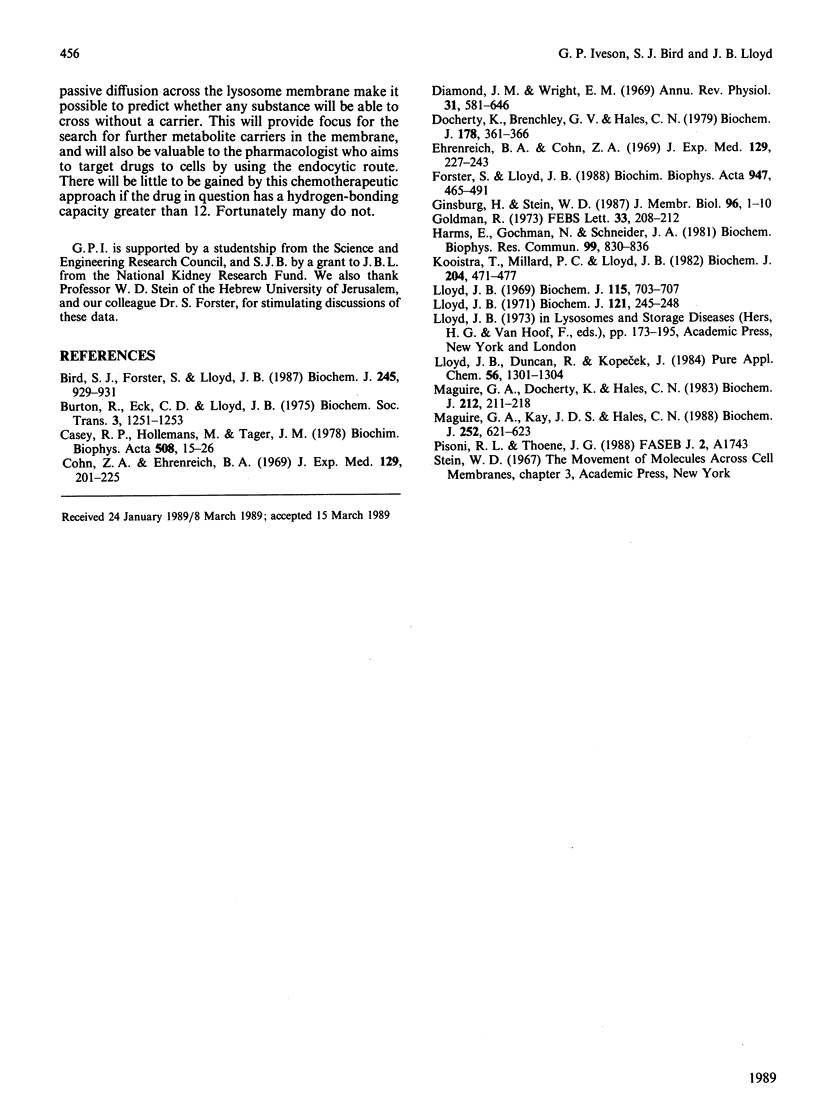Abstract
An osmotic-protection method has been used to study the permeability of rat liver lysosomes to 43 organic non-electrolytes of formula weights ranging from 62 to 1000. A lysosome-rich centrifugal fraction of rat liver homogenate was resuspended in an unbuffered 0.25 M solution of test solute, pH 7.0, and incubated at 25 degrees C for 60 min. The free and total activities of 4-methylumbelliferyl N-acetyl-beta-D-glucosaminidase were measured after incubation for 0, 30 and 60 min. Three patterns of results were seen. In pattern A the percentage free activity remained low throughout the 60 min incubation, indicating little or no solute entry into the lysosomes. In pattern B, the percentage free activity was initially low, but rose substantially during the incubation, indicating solute entry. In pattern C there was not even initial osmotic protection, indicating very rapid solute entry. The rapidity of solute entry into the lysosomes showed no correlation with the formula weight, but a perfect inverse correlation with the hydrogen-bonding capacity of the solutes. The results, which can be used to predict the ability of further compounds to cross the lysosome membrane by unassisted diffusion, are discussed in the context of metabolite and drug release from lysosomes in vivo.
Full text
PDF





Selected References
These references are in PubMed. This may not be the complete list of references from this article.
- Bird S. J., Forster S., Lloyd J. B. Translocation of sugars into rat liver lysosomes. Evidence against a common carrier for D-glucose and D-ribose. Biochem J. 1987 Aug 1;245(3):929–931. doi: 10.1042/bj2450929. [DOI] [PMC free article] [PubMed] [Google Scholar]
- Burton R. R., MacKenzie W. F. Heart pathology associated with exposure to high sustained +Gz. Aviat Space Environ Med. 1975 Oct;46(10):1251–1253. [PubMed] [Google Scholar]
- Casey R. P., Hollemans M., Tager J. M. The permeability of the lysosomal membrane to small ions. Biochim Biophys Acta. 1978 Mar 21;508(1):15–26. doi: 10.1016/0005-2736(78)90185-2. [DOI] [PubMed] [Google Scholar]
- Cohn Z. A., Ehrenreich B. A. The uptake, storage, and intracellular hydrolysis of carbohydrates by macrophages. J Exp Med. 1969 Jan 1;129(1):201–225. doi: 10.1084/jem.129.1.201. [DOI] [PMC free article] [PubMed] [Google Scholar]
- Diamond J. M., Wright E. M. Biological membranes: the physical basis of ion and nonelectrolyte selectivity. Annu Rev Physiol. 1969;31:581–646. doi: 10.1146/annurev.ph.31.030169.003053. [DOI] [PubMed] [Google Scholar]
- Docherty K., Brenchley G. V., Hales C. N. The permeability of rat liver lysosomes to sugars. Evidence for carrier-mediated facilitated diffusion. Biochem J. 1979 Feb 15;178(2):361–366. doi: 10.1042/bj1780361. [DOI] [PMC free article] [PubMed] [Google Scholar]
- Ehrenreich B. A., Cohn Z. A. The fate of peptides pinocytosed by macrophages in vitro. J Exp Med. 1969 Jan 1;129(1):227–245. doi: 10.1084/jem.129.1.227. [DOI] [PMC free article] [PubMed] [Google Scholar]
- Forster S., Lloyd J. B. Solute translocation across the mammalian lysosome membrane. Biochim Biophys Acta. 1988 Oct 11;947(3):465–491. doi: 10.1016/0304-4157(88)90004-4. [DOI] [PubMed] [Google Scholar]
- Ginsburg H., Stein W. D. Biophysical analysis of novel transport pathways induced in red blood cell membranes. J Membr Biol. 1987;96(1):1–10. doi: 10.1007/BF01869329. [DOI] [PubMed] [Google Scholar]
- Goldman R. Dipeptide hydrolysis within intact lysosomes in vitro. FEBS Lett. 1973 Jul 1;33(2):208–212. doi: 10.1016/0014-5793(73)80194-2. [DOI] [PubMed] [Google Scholar]
- Harms E., Gochman N., Schneider J. A. Lysosomal pool of free-amino acids. Biochem Biophys Res Commun. 1981 Apr 15;99(3):830–836. doi: 10.1016/0006-291x(81)91239-0. [DOI] [PubMed] [Google Scholar]
- Kooistra T., Millard P. C., Lloyd J. B. Role of thiols in degradation of proteins by cathepsins. Biochem J. 1982 May 15;204(2):471–477. doi: 10.1042/bj2040471. [DOI] [PMC free article] [PubMed] [Google Scholar]
- Lloyd J. B. A study of permeability of lysosomes to amino acids and small peptides. Biochem J. 1971 Jan;121(2):245–248. doi: 10.1042/bj1210245. [DOI] [PMC free article] [PubMed] [Google Scholar]
- Lloyd J. B. Studies on the permeability of rat liver lysosomes to carbohydrates. Biochem J. 1969 Dec;115(4):703–707. doi: 10.1042/bj1150703. [DOI] [PMC free article] [PubMed] [Google Scholar]
- Maguire G. A., Docherty K., Hales C. N. Sugar transport in rat liver lysosomes. Direct demonstration by using labelled sugars. Biochem J. 1983 Apr 15;212(1):211–218. doi: 10.1042/bj2120211. [DOI] [PMC free article] [PubMed] [Google Scholar]
- Maguire G. A., Kay J. D., Hales C. N. Lysosomal sugar transport: facilitated or free diffusion? Biochem J. 1988 Jun 1;252(2):621–623. doi: 10.1042/bj2520621. [DOI] [PMC free article] [PubMed] [Google Scholar]


